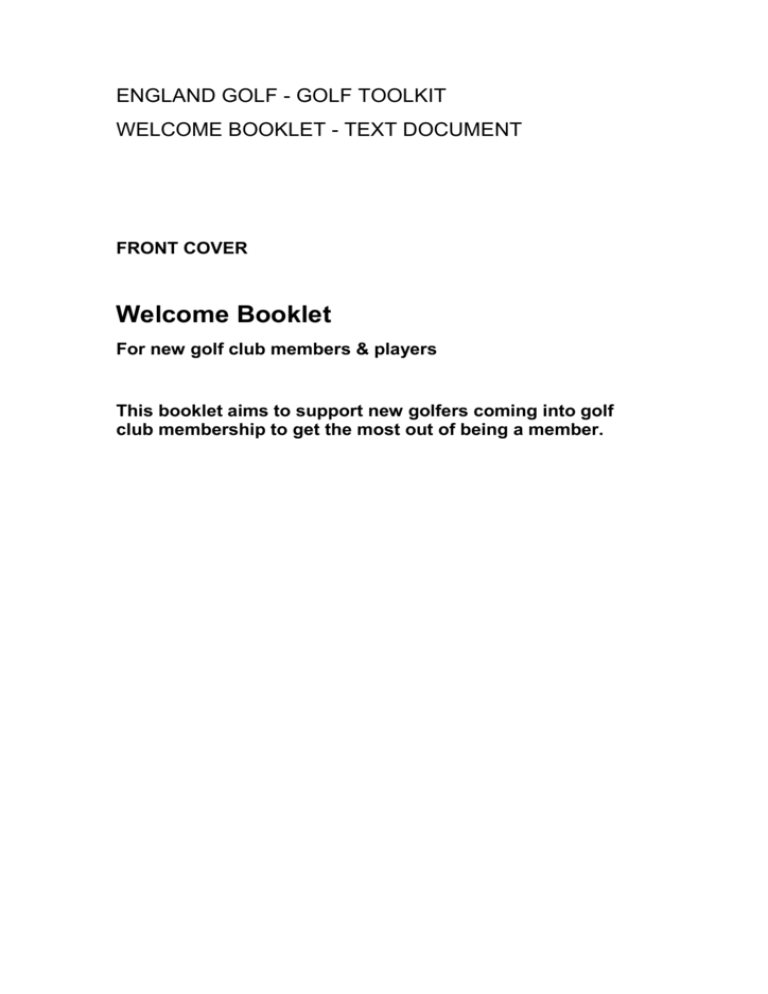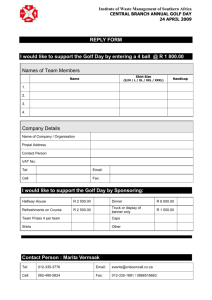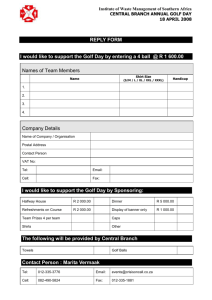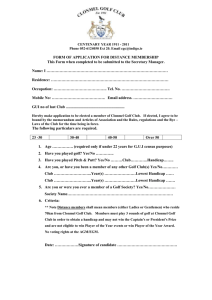England Golf Welcome Booklet Text Word version
advertisement

ENGLAND GOLF - GOLF TOOLKIT WELCOME BOOKLET - TEXT DOCUMENT FRONT COVER Welcome Booklet For new golf club members & players This booklet aims to support new golfers coming into golf club membership to get the most out of being a member. 1/ Golf Club Details Role of the ENGLAND GOLF England Golf (EG) are the governing bodies for both men’s and women's amateur golf respectively. In 2005, the EGU, EWGA and Professional Golfers' Association (PGA), with the support of the Golf Foundation and Sport England formed the England Golf Partnership (EGP) to help ‘Grow the Game’. England Golf have developed a variety of initiatives and resources to help develop the game of golf in England. What is the Welcome Booklet? The Welcome Booklet is a generic document, which aims to educate new members and players on the fundamentals of golf and the golf club environment. This information will help new golfers to get the most out of the game and enjoy the experience of being a golf club member. Your Golf Club: Secretary/Manager: Tel No: Email: Web address: Name of Professional: Tel No: Email: Who’s Who • Secretary/Manager Normally a paid member of staff who is responsible for the day to day running of the golf club. If you have any general queries then this person is always a good starting point. • PGA Professional/s Usually runs the golf shop and delivers coaching. They may also represent the club in competitions and offer golfing advice to members on rules and competitions etc. • Committee/Management Board Dependant upon club structure, there may be a committee or board, with sub committees to look after different areas of club life, such as membership, competitions and forward planning. • Greens Staff Responsible for the upkeep of the course, they normally work during the early part of the day to avoid the busy playing times. • Ranger/Marshall Some clubs have a ranger or marshall to go out onto the course and help golfers if they have questions and/or need assistance. They also monitor speed of play and conduct. * Junior Organiser/s Coordinator for the junior section who arranges coaching and competitive activities for juniors (members and non-members). 2/ Benefits of Being a Golf Club Member Golf Club Membership Benefits •Obtaining an official golf club handicap (CONGU) – see page 16/17. Allows play in Open competitions, club competitions, regional leagues and alliances. When playing other courses, you may be required to show proof of an official handicap. •Access to a range of competitions and social golf on a regular basis. •Good for your health. •Access to coaching with a qualified PGA Professional. •Access to other golf courses through matches, competitions and reciprocals. •Sense of belonging to a club and opportunity to make new friends. •An activity the whole family can participate in. •Clubs should have Public Liability insurance, but individuals should provide their own. Golf Club Facilities Golf clubs offer differing levels of facilities – details can be found at EG Golf Central see www.englandgolf.org/golfcentral • A golf course – usually 18 holes, but might be 9, 27 or 36 holes. • Clubhouse – normally with changing rooms, golf shop, office, bar and/or restaurant. • Putting/chipping green – for use to warm up and practice on. • Driving range/practice ground – practice area for golfers. Discounts on golf balls may be available for members. • Practice nets – available at some clubs to practice at prior to teeing off. • Lockers – found in the changing rooms. The Secretary/Manager should be able to explain how to obtain one. • Trolley/buggy shed – some clubs may provide space for members to leave their trolleys. Trolleys and buggies may also be available to hire. • Professional shop – usually provides golfing equipment, clothing plus drinks and snacks. 3/ General Club Information • Notice boards These are a good source of information for members and are normally split up into different categories. Some notices are there for information but others require your input, such as signing up for matches, entering competitions and updates for handicaps following competitions. • Club Diary/Handbook Some golf clubs issue members with a club handbook or diary, this usually has the competitions, matches and events for the forthcoming year. Other information normally contained are club contact details, rules of the club, opening hours, dress codes, green fee breakdown(s), who's who and other useful information about how the club operates. • Membership sections There are usually different membership sections within the golf club such as Mens, Ladies and Juniors. Further information on each section can be found on the relevant notice boards or through the Club Secretary/Manager. • Dress Codes & General Club Rules An important part of golf club membership is that members are aware of club rules and abide by them, they are there to make the game more enjoyable and to help with the smooth running of the club so that everyone understands the do’s and the don’ts. • Tee Times & Reservations How members reserve tee times varies. Tee reservations are usually for competitions and visiting parties and members can usually play when they want outside of these times. Members need to be aware that visiting parties are an important income for the golf club and need to be made welcome as it may subsidise the yearly membership subscriptions. Some clubs may operate a booking system where you book your tee time in advance. 4/ The Golf Course & Outdoor Facilities All golf courses vary in terms of layout, what they look like and the length of the course. It is important that you orientate yourself with the layout of the course and you should be able to obtain a course plan guide to help you. Courses are often referred to as Links, Parkland, Heathland or Woodland courses. Links On the coast, normally few trees but lots of bunkers, sand dunes, well draining and firmer under foot. Wind is normally a main factor when playing. Parkland Inland and often set in amongst mature trees. They may have ponds and other water hazards and the holes often meander through the trees. Heathland On sandier land inland, normal features are gorse bushes, bunkers, heather and fewer trees. Woodland The holes tend to be lined with many trees and the other holes are therefore hidden from view. • Tees Tees are the starting point of a golf hole, normally a flat piece of land, which is mown neatly and may be called the Tee Box. The teeing area is identified by two markers, these vary and are coloured to show which tees should be used by who: White Medal competitions for men, some clubs also allow them to be used during the summer months for casual golf. Yellow Everyday use for the men, some clubs use for competitions. Red Normally for ladies’ everyday use and competitions. The colour of tees is not compulsory and therefore may vary at your club. • Tee Furniture Refers to signs on the tee, which show the hole number, the length of the hole in yards (sometimes metres) and the stroke index of the hole (the stroke index determines where a golfer with a handicap gets their shots on the course – see Handicapping section). • Fairways Closely mown grass areas that go from in front of the teeing area and up to the green. Semi rough and then deeper rough normally surround the fairway. The rough is grass cut longer than the fairway and is intended to penalise players that miss the fairway. • The Green The area that you are trying to get the ball onto, as this is where the hole is situated. They are well maintained areas of grass that are mown very low so that they are a smooth surface for putting on. They vary in size and shape and have differing levels of slope. The hole location on a green is moved by the greens staff on a regular basis. • Hazards Occur as golf courses are made up of many different features, trees, length of grass, bunkers, water and bushes. If you hit your ball straight, it is rare to encounter hazards but if you go off line they come into play. They break up the landscape but also make golfers manage their way around the course. Some brief descriptions of hazards you may encounter are shown on the opposite page: Bunkers A hazard consisting of a prepared area of ground, often a hollow, from which turf or soil has been removed and replaced with sand or the like. Water Hazards Any sea, lake, pond, river, ditch, surface drainage, ditch or other open water course (whether or not containing water) and anything of a similar nature on the course. Lateral water hazard A water hazard or part of a water hazard so situated that it is not possible, or is deemed by the committee to be impracticable, to drop a ball behind the water hazard in accordance with the rules. Rough Grass grown longer than that on the fairway. Local Rules Local rules are specific to your club and it is important that you make yourself aware of them as they may have an influence on the interpretation of the rules of golf. They are in place for local features such as young trees that may be staked and therefore you may get a free drop. 5/ What do you need to Play Golf? Clothing Firstly check with the clubs dress code to see what is acceptable, but clothing needs to comfortable and appropriate for the weather conditions. It is always advisable to carry some extra clothes and a set of waterproofs. Golf shoes are required to be worn to play on most golf courses. Golf shoes give you more stability when playing a shot and walking down slopes on the course. What should be in your golf bag? Here is a selection of equipment that you should have in your golf bag: 14 CLUBS - one should be a putter TOWEL to clean clubs UMBRELLA and WATERPROOFS BALL MARKERS and PITCH MARK REPAIRERS GOLF BALLS and TEES HAT (summer or winter) GOLF GLOVE MOBILE PHONE (switched off) DRINKS and SNACKS RULE BOOK SCORECARD and PEN/PENCIL Carrying a golf bag, using a trolley or a buggy Every golfer will have a set of golf clubs, they may vary in number and type but a golfer should not have more than 14 clubs in their bag. Golfers can either carry their bag, use a push/pull or electric trolley or they may be able to use a buggy. Carry bags are generally lighter and smaller in design. Trolley bags are bigger as they do not need to be carried and have more pockets on them for waterproofs, drinks etc. If buggies are available to use, please check specific conditions for usage. 6/ The Scorecard Explained Here is an example of a scorecard. Remember once you have filled your card in with your name, date, competition, handicap, shots received and course/tees played then exchange your card with one of your playing partners. Each hole has a number, or score listed for it, which is called Par. Depending on the length of a hole, it may be rated as Par 3, Par 4 or Par 5 and you can use the Par standard to help measure your own skill on different holes. (Score card visual and notations not included in this document) 7/ Handicapping The purpose of a Council of National Golf Union (CONGU) Unified Handicapping System is to enable all golfers to be able to compete on a fair and equitable level, regardless of skill, males and females alike. Affiliated golf club members can obtain an official CONGU handicap, which allows entry into club competitions and access onto other courses. More information on CONGU can be found at www.congu.com • What is a handicap and why do I need one? A golfer's handicap is a number assigned to him/her, which defines their skill/ability level. A handicap gives all standards of golfers an opportunity to play together or compete against one another on an equal level. In a stroke play event, a golfers handicap is deducted from his/her "gross" score (total shots taken) to provide a "nett" figure (total shots taken minus handicap). In a match play event, a player’s handicap determines how many shots they will either give to, or receive from, an opponent. • Golfers are divided into the following categories: CATEGORY 1 – handicaps of 5 or less CATEGORY 2 – handicaps of 6 to 12 CATEGORY 3 – handicaps of 13 to 20 CATEGORY 4 – handicaps of 21 to 28 CATEGORY 5 – handicaps of 29 to 36 (ladies only) Clubs may also operate a Junior Handicapping Scheme. They may issue handicaps from 29 to 54 for boys and girls. As and when juniors improve, they feed into the male and female handicap categories as above. Further details can be found at www.congu.com. • How to obtain your first handicap: An affiliated club member can be allotted an official CONGU handicap. Although clubs have different rules, in general a player must submit a minimum of 3 cards over 18 holes, which are signed by someone the club deems responsible. A handicap will then be allotted based on the best of these 3 cards. • How do I improve my handicap? A player should complete a handicap qualifying round (the handicap committee will stipulate whether a round can be classed as "qualifying") and return a nett score (gross score minus handicap) that is less than the competition scratch score (CSS). The CSS is a figure that is calculated after each handicap qualifying round. If the player beats the CSS by a stroke or more their handicap will be cut. For each shot, which finishes below the CSS, a player’s handicap will come down as follows: Category 1– 0.1 Category 2 – 0.2 Category 3 – 0.3 Category 4 – 0.4 Category 5 – 0.5 If the nett score falls within the "buffer zone" (one shot above the CSS for Category 1, two for Category 2 etc) or matches the CSS a handicap will not change. If a player returns a higher nett score than this their handicap will increase by 0.1. No matter how high a score is, a handicap will only go up by 0.1. If a card is not returned (No Return or NR) the handicap will also go up by 0.1. 8/ Golfing Definitions Addressing the Ball: Taking your stance and grounding the club, except that in a water hazard a player simply addresses the ball by taking a stance. Air shot: Striking at the ball intentionally and missing it. It is counted as one shot. Casual Water: A temporary accumulation of water on the course where you may take a free drop. Divot: Turf that is removed from the ground when a player’s swing hits the grass. Dog-leg: A hole that does not follow a straight line from the tee to the green. Draw: A shot that curves in slightly from right to left. Fade: A ball that curves in slightly from left to right. Fore: A warning shouted to alert other players that a ball in flight is heading in their direction. Gross Score: The actual number of strokes a player has taken before his/her handicap is deducted. Grounding the Club: Touching the surface or ground with the sole of the club at address. Ground Under Repair (GUR): A damaged area of the course in which you may take a free drop. Honour: The right to play from the teeing ground; determined by the lowest score on the previous hole or on the first tee by the flip of a coin. Hook: A ball that starts right of your target and curves left. Loft of the Club: The amount or degree of loft that is built into the clubface. Loose Impediment: Natural objects that are not fixed or growing, such as twigs, loose rocks, pine cones, leaves. Lost Ball: Any ball that cannot be found within 5 minutes of starting to look for it and wasn’t seen to go into a water hazard of any type. Nett Score: A player’s score having subtracted the handicap from the gross or actual score. Obstruction: Anything artificial or man-made whether erected or left on the course, as well as artificially constructed roadways or paths. Out of Bounds: Any areas outside the boundaries of the course in which play is prohibited, as defined by white stakes. Penalty Stroke: A stroke added to the score for an infraction of the rules. Pitch Mark: An identification made by a ball landing on a green. Provisional Ball: Another ball that is played when you think your ball might have gone out of bounds or is lost. Stance: The position of the feet when addressing the ball. Stroke: The name given to each attempt to strike the ball. Take a Drop: The name given to the act of picking up the ball and dropping it in another spot in accordance with the rules. Through the Green: All of the area of the course with the exception of the teeing ground, the green and any hazard. Topped: A rolling or low bounding shot that is caused by striking the ball above the centre line. Wrong Ball: Any ball other than the ball in play, a provisional ball or in stroke play a second ball. For more golfing definitions visit www.getintogolf.org 9/ Competitions / Matches Each golf club will run club competitions, they will vary in format and will endeavour to cater for golfers of all abilities. Some will be run at the club, others may involve playing at other clubs, through alliances and local leagues – speak to your Club Secretary/Manager for further information. • Medal Competitions – Scratch This is where only gross scores count, handicaps are not taken into consideration. This format is normally used for category 1 golfers. The Club Championship for the Men, Ladies and Juniors would usually use this format. • Medal Competitions – Handicap This is the format most commonly used by golf clubs for their monthly medals and other medal competitions. A player subtracts their handicap away from the total shots taken to give their nett score. The players will be split into categories based on their handicap, there are normally four divisions (see page 17 for more info). • Stableford Competitions This is a popular format for competitions, as one or two bad holes do not stop you competing as per the medal format. Rather than the number of shots for the hole, you have a points system. Points are awarded in the following way: • Above bogey 0 points • Bogey (1 shot over par) 1 point • Par 2 points • Birdie (1 shot under par) 3 points • Eagle (2 shots under par) 4 points • Albatross (3 shots under par) 5 points Your shots are based on your handicap as follows; • A player off 6 handicap gets a shot at the holes with stroke index 1–6. • A player off 18 handicap gets a shot at each hole. • A player off 24 handicap gets 2 shots at stroke index holes 1–6 and 1 shot at stroke index holes 7–18. • Foursomes In this format players (in pairs) hit alternate shots. Each player will hit 9 tee shots and then take it in turns until holing out. It is a quick format of golf as players can walk ahead to a point near to where their partner will hit the ball. You can either play in medal or Stableford format. • Greensome This format is very similar to foursomes, the difference being that both players tee off at each hole, then pick one of the players drives (normally the best one) and the other player then plays and in turn from there until holing out. • Texas Scramble This is played in a 3 or 4 player team format. You all tee off, all the players hit their second shot from where the best drive landed, then all hit a 3rd shot from where the best 2nd shot finished and so on until the hole is completed. • Match Play A form of competition in which each hole is a separate competition, players can either win, lose or halve a hole, the winner is determined by the number of holes won rather than the gross, nett or stableford score. Once a player is up by a number of holes and there are less holes left to play then they have won, i.e. 5up with 4 holes to play, the player has won 5&4. If a match is all square at the end then you may need to play extra holes until there is a winner, referred to as sudden death. • Knock out Competitions Using the match play format, most clubs will run a variety of knock out competitions, these can either be singles, foursomes, better ball, mixed or for handicap categories. The Player Pathway In England there are coaching and playing opportunties known as the player pathway from schools to national squads, with opportunities available at club, county and national level. For further information on the individual areas, contact the EGU and EWGA direct. (Pyramid visual not included in this document). 10/ Important Tips Code of conduct • Respect your fellow golfers. • Be courteous at all times. • Play fair and honest. • Listen, learn and try to improve. • Practice hard. • Look smart, be polite and stay healthy. • Treat others as you expect to be treated yourself. • Be a role model to juniors. Etiquette In golf the way you behave on and off the course is very important. Good behaviour is called ‘etiquette’. It is important for three reasons: • To make sure you are safe. • To make sure you look after the course. • To make sure you don’t hold up players behind you. Preparation to play You will always play better if you are prepared to play and are not rushing: • Try to arrive at least 30 minutes before you are due to play. • Get to the first tee 5 minutes before your tee time. • Always count the number of clubs in your bag, no more than 14! • Warm up by stretching and hitting some practice balls/putts before playing. • Shake hands and introduce yourself to your playing partner(s). • Put a mark on your ball, such as your initials or a coloured dot, so that you know it is yours. • Have tees, a ball marker and a pitch mark repairer in your pocket ready to use. • Get a drink, thirst leads to mental fatigue! • Refer what should be in your bag, information on page 12. • Check local rules (usually on the back of a scorecard). Respect Show respect for your opponent(s) by removing your hat when you shake hands at the end of the game, whether you have won or not! Pre shot routines • Keep it brief. • Choose a shot you feel you can achieve. • Focus on a point where you are hitting the ball. • Keep thoughts on your technique to a minimum. • Commit to the shot. On the Green • Always repair your pitchmark, if you can’t find your own, repair another. • Lift don’t drag your feet to avoid making spike marks. • Offer to attend the flagstick for your opponent. • Mark your ball if it is in the way of another player’s line to the hole. Safety first • Always remember that golf is dangerous if certain rules are not observed. • Be aware of other players and where they are in relation to you. • Stand a safe distance from anyone swinging their club, they may not know you are there. Never step in front of the hitting line or tee. • Make sure you have room to swing your club. Never swing a club towards someone else. • Shout ‘’FORE!’’ immediately if you think your ball may hit someone. • Duck and cover your head if you hear ‘’FORE!’’ shouted at you and face away from where the shout has come from. If you follow these tips you are more likely to enjoy your round of golf and so are other golfers. BACK COVER England Golf Development Team The National Golf Centre, Woodhall Spa, Lincs LN10 6PU Tel: 01526 354500 Email: development@englandgolf.org www.golfclubtoolkit.org



